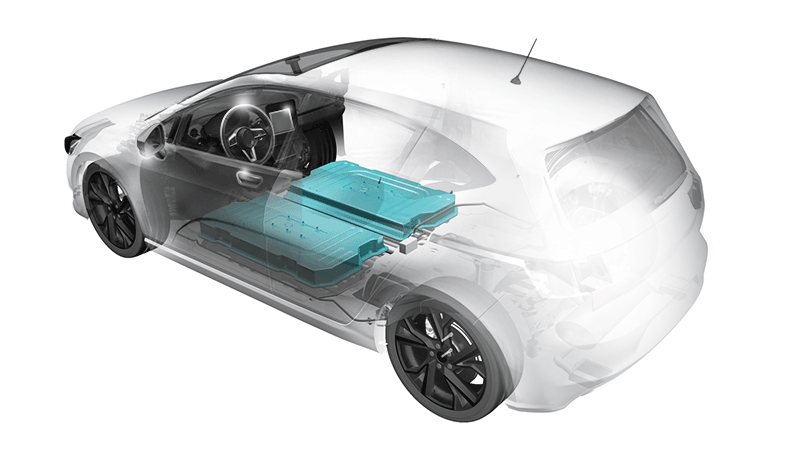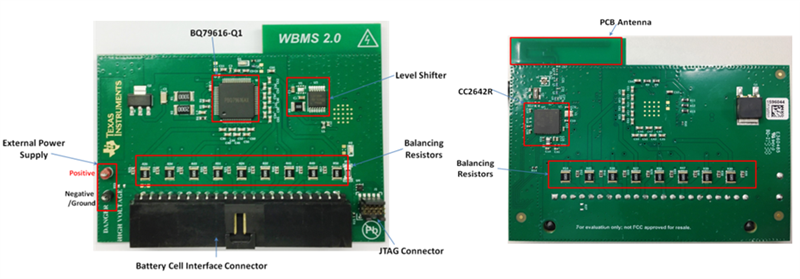SSZT336 february 2020 BQ79616-Q1 , CC2642R-Q1 , CC2662R-Q1

Lithium battery cells are continuously getting more affordable and energy dense, and can drive hybrid electric vehicles (HEVs) and electric vehicles (EVs) farther, longer. With these advancements, automotive design engineers can now turn their attention to further enhancing efficiency by reducing the size and weight of the battery management system (BMS).
For background on battery management systems, see “HEV/EV battery management systems explained simply.”
The traditional wired BMS architecture connects battery packs using wire harnessing in a daisy-chain configuration, which is cumbersome to manufacture, often requires maintenance, and is difficult to service.
| Wired versus Wireless Communications in EV Battery Management | |
| Read the white paper | |
To overcome these challenges, an evolution to wireless BMS shows potential, with wireless chipsets working in conjunction with battery monitors to communicate and pass voltage and temperature data from each cell to the main microcontroller in the system. The inherent reduction in the number of required cables and harnesses lowers vehicle weight and saves costs.
Figure 1 is an example of a wireless BMS architecture.
 Figure 1 TI’s wireless BMS architecture
Figure 1 TI’s wireless BMS architectureIf you’re exploring the idea of switching to a wireless BMS architecture, here are three key questions to consider:
Is it reliable?
Although wireless communication is already replacing cables in various applications, one critical point to consider is the reliability of the wireless link and network. You can quantify reliability using packet error rates and the probability of successfully sending a message between a transmitter and a receiver. This probability should be 99.999%, with a packet error rate of 10-7.
Is the wireless BMS safe for passengers, mechanics and property?
A wireless BMS should accurately monitor conditions and respond quickly, reliably and safely if a hazardous event is detected to mitigate danger or destruction. Ideally, the system should meet requirements up to Automotive Safety Integrity Level D, which is the highest functional safety goal defined by the International Organization for Standardization 26262 road vehicle standard.
| Comply with ISO 26262 ASIL D in Your Wireless BMS Design | |
| Read the white paper | |
Is it secure?
Will a wireless BMS work if someone attempts to tamper with the vehicle’s battery system? Look for systems that provide encrypted messages, using security enablers such as cryptographic accelerators with key exchange and refreshment mechanisms, message integrity checks and debugging security.
Bonus question! Which is best: wired or wireless BMS?
This is a trick question, because either a wired or wireless BMS may be appropriate for your design, depending on your automotive architecture and design goals. Table 1 compares the main differences between a wired and wireless system.
| Considerations | Wired BMS | Wireless BMS |
|---|---|---|
| Weight | Wiring increases overall vehicle weight. | A wireless system decreases vehicle weight. |
| Design flexibility and serviceability | Less flexibility with a larger footprint overall; more difficult to service. Larger overall footprint; less flexible system design due to cumbersome wires, difficult to service. | Smaller footprint enables more flexibility with a simpler design and placement within the vehicle. Easier to service. |
| Measurement | Time-synchronized measurements of voltage and current can be a difficult design challenge. | Wireless systems naturally enable time-synchronized measurements and provide the ability to add more synchronized sensing capabilities. |
| Reliability | Wiring harnesses tend to break over time; they are difficult to repair and require rewiring of battery packs. | No wires to maintain; design has to overcome harsh automotive radio-frequency environments and non-line-of-sight challenges. |
| Security | Contained and fully secure system communication. | Possible to breach poorly designed systems that lack security protocols. |
Wired battery management systems are tried, true and not going anywhere soon; but wireless BMS are the next evolution. In fact, with Strategy Analytics estimating 36 million EVs on the road by 2026, wireless BMS offer promising ways to make vehicles more efficient and reliable – features that appeal to both original equipment manufacturers and consumers.
To learn more about our wireless BMS solutions see TI.com/wbms. To browse featured products, see CC2662R-Q1 wireless MCU and BQ79616-Q1 battery monitor and balancer.